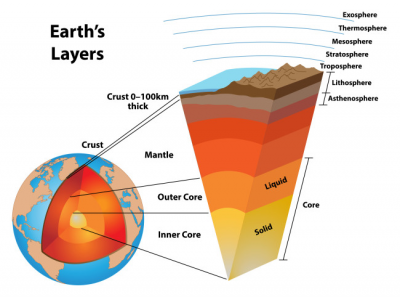
Earth’s Crust
The crust is what we live on and is by far the thinnest of the layers of earth. The thickness varies depending on where you are on earth, with oceanic crust being 5-10 km and continental mountain ranges being up to 30-45 km thick. Thin oceanic crust is denser than the thicker continental crust and therefore ‘floats’ lower in the mantle as compared to continental crust. You will find some of the thinnest oceanic crust along mid ocean ridges where new crust is actively being formed. In comparison, when two continents collide as in the case of the India Plate and Eurasia Plate, you get some of the thickest sections of crust as it is crumpled together.
The temperatures within Earth’s crust will vary from air temperatures at the surface to approximately 870 degrees Celsius in deeper sections. At this temperature, you begin to melt rock and form the below-lying mantle. Geologists subdivide Earth’s crust into different plates that move about in relation to one another.
Given that Earth’s surface is mostly constant in area, you cannot make crust without destroying a comparable amount of crust. With convection of the underlying mantle, we see insertion of mantle magma along mid ocean ridges, constantly forming new oceanic crust. However, to make room for this, oceanic crust must subduct (sink below) continental crust. Geologists have studied extensively the history of this plate movement, but we are sorely lacking in determining why and how these plates move the way they do.
Earth’s crust “floats” on top of the soft plastic-like mantle below. In some instances mantle clearly drives changes in the crust, as in the Hawaiian Islands. However, there is ongoing debate whether oceanic crust subduction and mid ocean ridge spreading is driven by a push or pull mechanism.
In very broad terms, oceanic crust is made up of basalt and continental crust is made up of rocks similar to granite. Below the crust is a solid relatively cooler portion of the upper mantle that is combined with the crust to make the lithosphere layer. The lithosphere is physically distinct from the below-lying layers due to its cool temperatures and typically extends 70-100 km in depth.
Below the lithosphere is the asthenosphere layer, a much hotter and malleable portion of the upper mantle. The asthenosphere begins at the bottom of the lithosphere and extends approximately 700 km into the Earth. The asthenosphere acts as the lubricating layer below the lithosphere that allows the lithosphere to move over the Earth’s surface.
Credit: Forbes
Picture credit: Google




